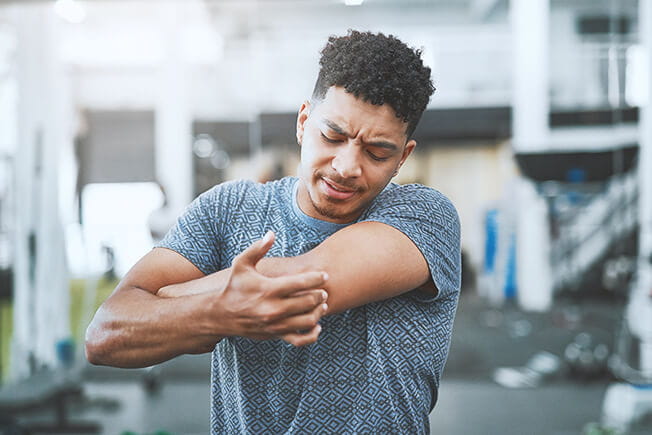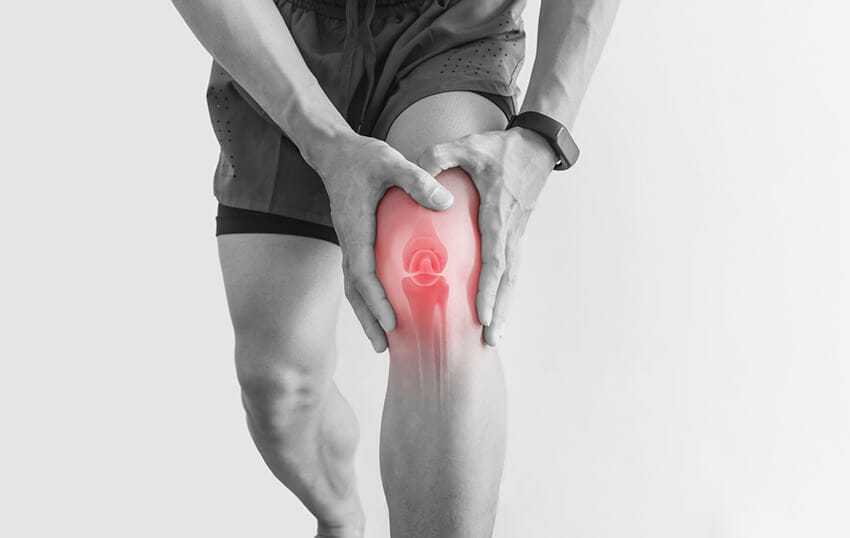Tennis elbow, swimmer’s shoulder, and runner’s knee: These common injuries aren’t always sports-related

Athletes put their bodies through a lot, and in many cases, have at least a few injuries to show for it. In fact, there are injuries named for the sports that are often the culprit, from tennis elbow to swimmer's shoulder to runner's knee.
Despite their names, these injuries aren't always sports-related. You can experience any of them without ever stepping onto a court or jumping into a pool.
Tennis elbow, swimmer's shoulder, and runner's knee are all injuries that come from a specific motion. While these movements may be more common in certain sports, they can also be a part of your everyday life.
Here's a look at tennis elbow, swimmer's shoulder, and runner's knee — including what can cause them and what you can do about them.
Tennis elbow: Not just for racquet-swingers
Swinging a tennis racquet (or badminton, squash, or pickleball racquet) over and over again can, unsurprisingly, put strain on your elbow. But you don't have to pick up a racquet to experience this overuse injury.
According to Christopher Kester, DO, "Tennis elbow — also known as lateral epicondylitis — is characterized by inflammation or tiny tears in tendons (tissue that connects muscle to bone) of your forearm muscles, which are right next to your elbow. By repeating the same motion again and again, these muscles and tendons can become damaged, leading to tenderness and pain on the outside of your elbow."
Causes of tennis elbow
While tennis players are particularly susceptible to tennis elbow, anyone who repeatedly uses the forearm muscle or extends the wrist and hand is at risk. This includes:
- Other athletes, such as golfers, fencers or weightlifters
- Painters
- Carpenters
- Plumbers
- Car mechanics
- Butchers
- Cooks
- People who type for the majority of their profession
Symptoms of tennis elbow
Tennis elbow usually comes on gradually, starting mild and then slowly becoming more painful. In most cases, there isn't just one injury that can be pinpointed as the start of symptoms.
Symptoms of tennis elbow include:
- Burning or pain on the outer side of the elbow, including at night
- Weakened grip
- Swelling around the elbow joint
- Increased pain with forearm activity, like turning a wrench, shaking hands, or holding a racquet
Treatment for tennis elbow
There are many ways to treat tennis elbow, most of which don't involve surgery. Treatment options include:
- Rest, especially from activities that involve the arm
- Over-the-counter medications, such as acetaminophen or ibuprofen
- Physical therapy to strengthen forearm muscles
- Wearing a forearm brace
- Steroid injections, such as cortisone, to reduce inflammation
- Surgery to remove damaged muscle and reattach healthy muscle to the bone
Swimmer's shoulder: Pain beyond the pool
"With nearly every stroke in the water, swimmers ask a lot of one part of their body — their shoulders. However, this overhead movement of the arm isn't unique to swimming, and plenty of other people can experience a similar type of shoulder pain," explains Dr. Kester.
Swimmer's shoulder — also known as shoulder impingement or rotator cuff tendinitis — is when you have pain in your shoulder. This pain is usually related to damage or irritation to the rotator cuff. The rotator cuff is a group of muscles that create a covering around the head of the upper arm bone, keeping it attached to the shoulder blade and helping you move your arm.
Causes of swimmer's shoulder
Anytime you move your arm overhead, you're using your rotator cuff. This movement is common in most swimming strokes, but it's also prevalent in other sports and activities.
People who are at an increased risk of swimmer's shoulder include:
- Other athletes, like baseball and tennis players
- Construction workers
- Painters
- People who hang wallpaper or billboards
While swimmer's shoulder is usually caused by overuse, it can also be a result of a minor shoulder injury.
Symptoms of swimmer's shoulder
Swimmer's shoulder pain usually starts mild and progresses over time. Symptoms include:
- Swelling and tenderness at the front of the shoulder
- Minor pain — both during activity and when resting
- Pain and stiffness when moving the arm, especially with lifting and reaching movements
- Loss of strength and/or motion
- Trouble placing the arms behind the back, such as to button or zipper clothing
Treatment for swimmer's shoulder
The goal of treating swimmer's shoulder is to restore function and reduce pain. Most of the time, this doesn't require surgery. Treatment options include:
- Rest, especially from overhead movements of the arm
- Over-the-counter medications, like ibuprofen and aspirin, to reduce pain and swelling
- Physical therapy to improve range of motion of the shoulder and strengthen the rotator cuff muscles
- Steroid injections, such as cortisone, to reduce inflammation
- Surgery to make more space for the rotator cuff

Runner's knee: Not only a running injury
Runners ask a lot of their knees during every run. But plenty of other people put a similar demand on this major joint, which can lead to knee pain and injuries.
Runner's knee — also known as jumper's knee or patellofemoral pain syndrome — is pain in the front of the knee and around the kneecap. The condition can make it difficult to do everyday activities, like kneeling down or climbing stairs.
Causes of runner's knee
The pounding of the pavement that runners know so well is a common culprit of runner's knee. However, there are other factors that can put the same pressure on your knees, including:
- Sports like cycling, football, and cross-country skiing
- Activities like squatting or climbing stairs
- Sudden increases in activity
- Changes in footwear
- Abnormal movement of the kneecap due to alignment problems or muscle weakness
Symptoms of runner's knee
Runner's knee pain usually starts mild and gets worse over time or with activity. Symptoms of runner's knee include:
- Dull, aching pain at the front of the knee
- Pain during movements like climbing stairs, running, or jumping
- Pain after sitting with the knees bent, such as on an airplane or at the movies
- Popping sounds in the knees when standing up or using stairs
Treatments for runner's knee
Simple changes in activity can often ease pain from runner's knee, but some cases may require other approaches. Treatments include:
- Avoiding activities that put stress on your knee
- Using the RICE method — rest, ice, compression, and elevation
- Over-the-counter medications, such as ibuprofen or naproxen
- Physical therapy to improve range of motion and strength
- Using shoe inserts (called orthotics) to properly align your foot and ankle
- In very rare cases, surgery to remove damaged tissue or realign the kneecap
Relieving pain for athletes and non-athletes
"Whether you're an avid athlete or have no interest in playing sports, overusing or improperly using parts of your body can lead to injuries and pain. This can come from your occupation, daily activities, or simply the way your body moves," says Dr. Kester.
With tennis elbow, swimmer's shoulder, and runner's knee, early treatment is key. The sooner you seek care, the more likely you are to avoid needing serious interventions. In many cases, simple modifications, strengthening exercises, and rest can help improve your symptoms.
Pay attention to your body, and slow down when it's giving you signs that something is wrong. Then, let your healthcare provider know if you're experiencing pain. This can help you avoid damage both now and in the future.
If you're experiencing pain in your elbow, shoulder, or knee, schedule an appointment with Main Line Health Orthopaedics by calling 1.866.CALL.MLH (225.5654).
 Content you want, delivered to your inbox
Content you want, delivered to your inbox
Want to get the latest health and wellness articles delivered right to your inbox?
Subscribe to the Well Ahead Newsletter.
